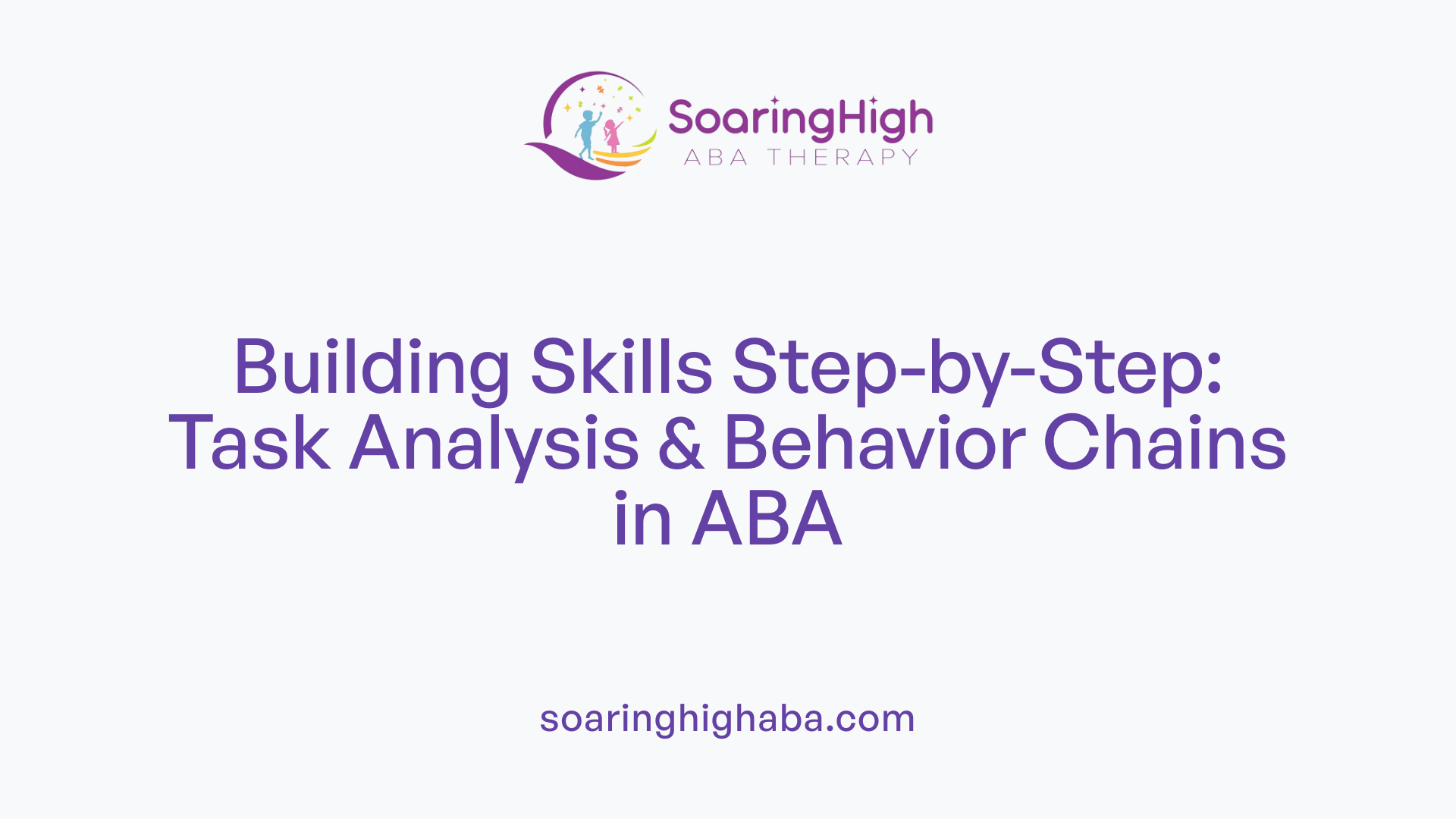Understanding the Foundations of ABA Therapy for Autism
Applied Behavior Analysis (ABA) is a scientifically validated approach widely used to support individuals with autism. By emphasizing personalized, structured interventions, ABA facilitates the development of critical life, social, and communication skills that lead to increased independence. This article explores how ABA therapy systematically promotes greater social autonomy, empowering individuals with autism to participate more fully in their communities.
Core Principles and Methods of ABA Therapy

What are the methods and principles of ABA therapy that promote independence?
Applied Behavior Analysis (ABA) therapy is renowned for its structured approach to fostering independence in individuals with autism. It relies heavily on reinforcement techniques, prompting, and fading to help learners acquire functional skills. Reinforcement involves rewarding desired behaviors to increase their occurrence, while prompting provides hints or assistance to perform a task correctly. Over time, prompts are gradually reduced through a process called fading, encouraging the individual to perform independently.
A vital component of ABA is task analysis, which breaks down complex activities into smaller, manageable steps. These steps are taught sequentially and linked into behavior chains, creating a logical flow from start to finish of a skill, such as preparing a snack or dressing. This sequencing makes learning easier and more accessible.
ABA programs often incorporate Natural Environment Teaching (NET) and Video Modeling, allowing skills to be practiced in real-life settings. These methods enhance relevance and facilitate generalization of skills across different environments.
Central to effective ABA therapy are individualized assessments that help set tailored goals based on each person's strengths and needs. Continuous progress monitoring and data collection enable therapists to adjust interventions promptly, ensuring effective and sustainable skill development. Collectively, these methods support the mastery and maintenance of skills necessary for independence, including communication, self-care, social, and daily living routines.
How does ABA therapy support the development of life skills for children and teens with autism?
ABA therapy fosters the development of essential life skills by employing evidence-based strategies like reinforcement, prompting, and data tracking. These strategies help teach vital skills such as effective communication, personal hygiene, dressing, and safety awareness.
Programs are customized to meet individual needs and goals, ensuring that each person receives targeted instruction. For example, teaching someone to request items using Picture Exchange Communication System (PECS), or to brush teeth and manage meal preparation, are common focus areas.
Delivery of therapy occurs across various settings—home, school, and community environments—encouraging practice in real-life contexts. This promotes generalization of skills so that they can be applied beyond the therapy session.
By targeting helpful behaviors and reducing problematic actions, ABA increases daily functioning and promotes confidence. It also prepares individuals for transitions such as school, work, and social participation, ultimately supporting greater independence.
How does ABA therapy enhance social independence in individuals with autism?
ABA enhances social independence by systematically teaching core social skills like understanding cues, turn-taking, and conversational engagement. Techniques such as role-playing, modeling, and social stories enable individuals to grasp social norms and appropriate responses.
Breaking social skills into smaller steps allows learners to master each component gradually, reinforcing positive interactions and reducing social anxiety. Communication development—whether verbal, non-verbal, or through assistive devices—significantly impacts social engagement.
Additionally, ABA promotes independence in daily routines related to social life, including self-care, cooking, and community navigation, which are vital for full social participation.
By fostering confidence and competence in social settings, ABA helps individuals build friendships and participate more fully in their communities, bolstering overall independence.
In what ways does ABA therapy enable individuals with autism to achieve greater social independence?
ABA implementation leads to greater social independence by teaching and reinforcing abilities such as interpreting body language, initiating conversations, and understanding social cues. Techniques like peer-mediated interventions and social stories offer practical opportunities for practicing these skills in natural settings.
Reducing challenging behaviors that hinder social interactions and promoting positive social behaviors are core focuses. By setting measurable, incremental goals, ABA encourages steady progress toward autonomy.
The personalized nature of ABA ensures that each individual’s unique social strengths and challenges are addressed, facilitating smoother integration into social environments and fostering meaningful relationships.
Overall, ABA provides a structured pathway for individuals with autism to develop essential social skills, leading to enhanced independence and quality of life.
What life skills are targeted by ABA to improve independence?
ABA targets an array of life skills crucial for independent living. These include self-care activities like brushing teeth, bathing, dressing, grooming, and toileting. Household management tasks such as cooking, cleaning, and organizing personal belongings are also emphasized.
Moreover, decision-making, problem-solving, and executive functions like planning and time management are integral components. Enhancing communication skills—understanding social cues, initiating interactions, and sharing—further supports social independence.
Training in safety awareness, navigating community resources, managing money, and vocational skills prepare individuals for adult responsibilities.
How do reinforcement and prompting techniques facilitate skill development?
Reinforcement and prompting are foundational in ABA, driving meaningful learning experiences. Positive reinforcement motivates learners by rewarding appropriate behaviors, fostering repetition and mastery.
Prompting provides cues—such as visual aids, gestures, or physical guidance—to assist learners in completing tasks correctly. As skills become more consistent, prompts are gradually faded to promote independence.
This combination encourages learners to perform skills reliably in various contexts, leading to increased autonomy and confidence in daily activities.
How does ongoing data monitoring support personalized interventions?
Consistent data collection and progress tracking enable therapists to evaluate what strategies work best. Analyzing this data allows for timely modifications to intervention plans, ensuring they remain aligned with the learner's evolving needs.
Monitoring helps identify when skills are mastered or when additional support is needed, optimizing the pace of learning. This personalized feedback loop guarantees interventions are effective, sustainable, and focused on meaningful improvements.
What role does family involvement play in fostering independence?
Family participation is vital in reinforcing skills learned through ABA. Training caregivers to apply ABA techniques ensures consistency across environments and promotes skill generalization.
Engaged families foster a supportive atmosphere, encourage ongoing practice, and help maintain behavioral gains. Such collaboration reduces stress and builds a cohesive support system, which enhances the likelihood of long-term independence.
How are social stories and peer-mediated approaches used to promote social interaction?
Social stories prepare individuals for specific social scenarios by illustrating appropriate behaviors and expectations, reducing anxiety and increasing understanding.
Peer-mediated approaches involve training peers to support social engagement, offering natural opportunities for practice. These strategies help individuals interpret social cues, initiate interactions, and maintain friendships.
Together, they make social learning engaging and practical, fostering social confidence and independence.
What benefits do structured ABA programs provide?
Structured ABA programs facilitate significant improvements in communication, self-care, social skills, and behavioral management. Participants often gain increased confidence, autonomy, and community involvement.
Many individuals successfully transition into adulthood with practical skills for work, independent living, and social participation. Continuous, data-driven reinforcement of progress ensures these improvements are lasting, greatly enhancing overall quality of life.
Integrating Social Skills Training into Daily Life

How does ABA therapy enhance social independence in individuals with autism?
ABA therapy plays a significant role in helping individuals with autism develop social independence. It teaches and reinforces essential social skills like understanding social cues, turn-taking, and engaging appropriately with others. Techniques such as role-playing, modeling, and positive reinforcement break down complex social behaviors into manageable steps, allowing individuals to practice and master skills like greetings, sharing, and expressing needs effectively. Communication development, whether verbal, gestural, or aided with devices, reduces frustration and encourages meaningful social interactions. Besides social communication, ABA helps foster independence in daily routines and self-care activities like grooming, cooking, and managing personal needs. This comprehensive approach builds confidence and functional skills, enabling individuals to participate more fully in their communities and daily life.
In what ways does ABA therapy support social participation and community involvement?
ABA therapy actively promotes social participation and engagement in community activities. It employs structured strategies such as social stories, social scripts, and peer-mediated approaches to teach individuals how to interpret social cues, initiate and sustain conversations, and participate in group settings. Role-playing and modeling prepare individuals for real-world interactions, boosting their confidence. The therapy emphasizes skill generalization across different environments, helping individuals navigate various social settings with competence. This not only enhances their social independence but also reduces feelings of social anxiety and isolation. As a result, individuals can join recreational groups, develop friendships, and take part in community events, leading to a more inclusive and active social life.
What role do social stories and social scripts play in ABA-based social skills training?
Social stories and social scripts are vital tools in ABA’s social skills training arsenal. Social stories describe specific social situations and appropriate responses in simple, clear language, helping reduce anxiety and improve understanding. They prepare individuals for upcoming social interactions by providing context and expectations. Social scripts, on the other hand, are rehearsed phrases or sequences that guide individuals in initiating conversations, sharing, and requesting help. These tools facilitate learning of social norms, improve communication, and help apply learned behaviors across real-life situations. Their use increases the likelihood of successful social interactions, fostering greater independence in social settings.
How does peer-mediated intervention support social skill development?
Peer-mediated intervention involves training typically developing peers to assist children with autism in developing social skills. Peers are taught how to initiate interactions, model appropriate behaviors, and encourage social engagement in informal settings. This approach creates natural opportunities for practicing social skills in a relaxed, real-world context. Peer support helps reduce social barriers by fostering inclusive environments where children with autism feel more comfortable and motivated to participate. It also encourages friendship formation and ongoing social practice, which are crucial for developing social independence and involvement in community activities. This strategy effectively extends learning beyond clinical settings, promoting lasting social growth.
| Aspect | Description | Additional Details |
|---|---|---|
| Social Skills Targeted | Understanding cues, turn-taking, sharing | Essential for everyday interactions |
| Techniques Used | Role-playing, modeling, reinforcement | Practical methods to teach behaviors |
| Tools | Social stories, social scripts | Structured aids for learning norms |
| Support Strategies | Peer-mediated approaches | Encourages natural social engagement |
| Outcomes | Increased independence, community participation | Better social integration and life skills |
Empowering Independence Through Tailored Strategies
ABA therapy’s structured and personalized methodologies serve as powerful tools in fostering social independence for individuals with autism. By systematically teaching social, communication, and life skills—while involving families, peers, and communities—ABA creates a supportive environment for meaningful growth. As individuals develop confidence and autonomy, they are better equipped to navigate everyday life, participate socially, and enjoy improved quality of life. Ongoing advancements and a collaborative approach ensure that ABA remains a vital resource in unlocking the full potential of those with autism, guiding them toward independent and fulfilling lives.
References
- ABA Therapy for Teens: Building Independence - Therapyland
- Promoting Independence in Kids with ABA Therapy
- 5 Ways ABA Therapy Supports Your Child's Independence
- The Benefits of ABA Therapy for Autism
- How ABA Therapy Builds Self-Care & Independent Living Skills
- Independence in Individuals with Autism: Role of ABA Therapy
- Boosting Social Skills and Communication Through ABA Therapy
- The Power of Progress: Applied Behavior Analysis (ABA) Therapy ...





































































































